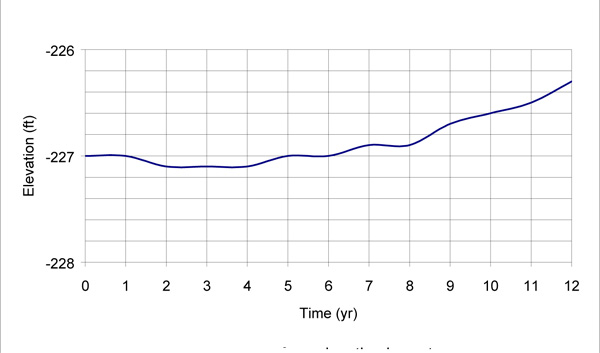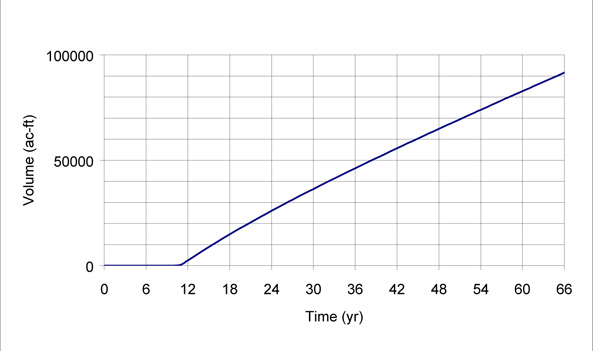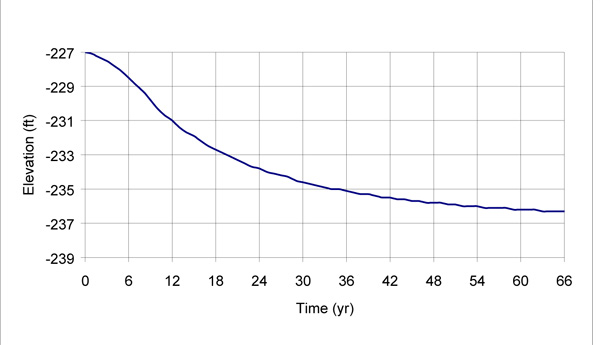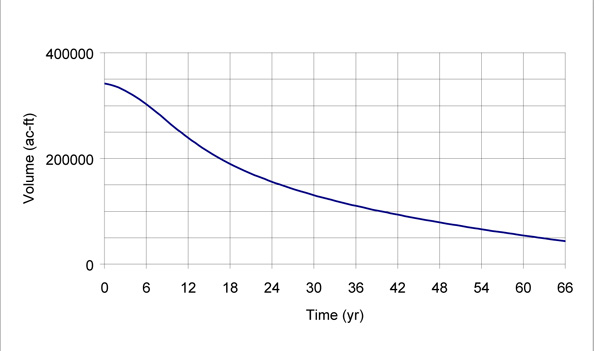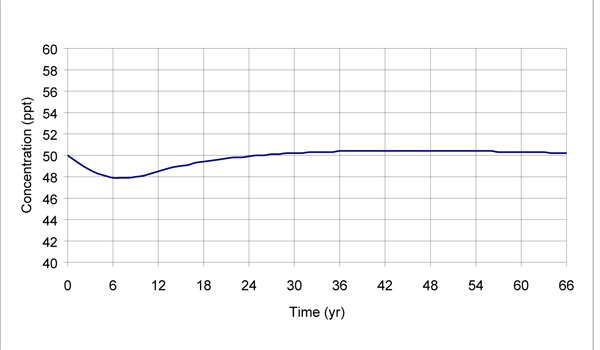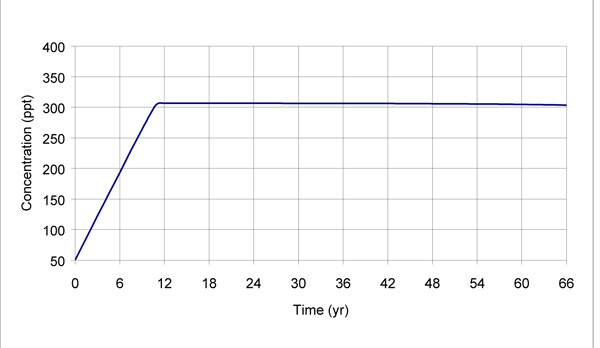


1. INTRODUCTION The restoration of the Salton Sea, in California, to sustain fisheries, wildlife, and recreational resources, is being considered at the state and national levels. The main objective of the restoration is to reduce the salinity of the lake to ocean level. A proposal to accomplish the restoration consists of the construction of a diked impoundment to enclose 50 sq mi (129.5 km2) of the lake, comprising about 1/7 of the total surface area. Water is expected to flow in one direction, from the main lake to the diked impoundment. The objective is to eventually reduce the salinity of the main lake from an initial value of 50 ppt (parts per thousand) to a target value of 35 ppt, while increasing the salinity of the diked impoundment to that of a concentrated brine. The restoration process is expected to take a few decades (Ogden 1996). The success of the diked impoundment project will depend on the extent to which the objectives of the restoration are met. These are: (1) the eventual reduction of the initial salinity of the main lake to the target salinity, and (2) the control of lake water surface levels. The lake-impoundment system is extremely sensitive to selected environ- mental parameters, among them, water in ows, lake evaporation rate, and threshold concentration for dissolved-solids precipitation. Therefore, mathematical modeling is necessary to provide a clearer understanding of the system's behavior to assist in the decision-making process. In this paper we develop a mathematical model of the salinity balance of the lake impoundment system. The model simulates water volumes and dissolved-solids concentration in main lake and diked impoundment throughout the restoration period. The main lake receives in flows from agricultural drainage, consisting of water and dissolved solids, at volumes of 1,322,000 ac-ft yr1 (1631 million m3 yr-1) and concentrations of 2.894 ppt, respectively (Ogden 1996). The water flows by gravity from main lake to diked impoundment. Thus, the inflow concentration of dissolved solids to the diked impoundment is that of the main lake, i.e., 50 ppt at the start of the operation, gradually decreasing as the salinity of the main lake is reduced. This paper reports on the simulation, using mathematical modeling, of the water and salt balance in the proposed lake-impoundment system. In this way, the impact of alternative management strategies can be determined a priori.
2. HISTORICAL PERSPECTIVE The Salton Sea is the largest lake in California, encompassing 378 mi2 (979 km2) in Imperial and Riverside counties (Fig. 1). The lake is below sea level, filling a depression known as the Salton Sink or Salton Basin, with its deepest point at -278 ft msl (-84.7 m). In the geological past, the Salton Basin was part of the Gulf of California, but it became separated from it due to sediment deposition in the Colorado River delta. The mean annual precipitation at the Salton Sea is 2.28 in. (57.9 mm); the mean annual lake evaporation is 70.8 in. (1798 mm) (Hely et al. 1966; Ogden 1996). The high evaporation/precipitation ratio depicts an extremely arid climate. Therefore, in the absence of artificial inflows, the lake has a tendency to dry up. In the Spring of 1905, a diversion of the Colorado river south of the U.S.-Mexico border failed during flood conditions. Then, for almost two years, the entire flow of the Colorado river changed direction and flowed northwestward into the Salton Sink, filling it up to -195 ft (-59.4 m), with a surface area of 520 mi2 (1347 km2). From its inception, the lake level decreased sharply through evaporation, reaching an all-time flow of -250 ft (-76.2 m) in the early 1920's (Ogden 1996). Since that time, agricultural activity expanded in the Imperial valley, immediately South of the Salton Sea. In 1928, an Executive Order designated lands within the Salton Basin below -220 ft (-67.05 m) as storage for wastes and seepage water from irrigated lands in the Imperial valley (Regional Water Quality Control Board 1994). Since then, the use of the Salton Sea as a repository of agricultural drainage has led to increased in flows to the lake. In the past 70 years, the lake level has risen gradually to its present level of -227 ft (-69.19 m). In 1907, the salinity of the Salton Sea was about 3.5 ppt. By 1916, the salinity had increased to 16 ppt, primarily due to the solution of large quantities of minerals that had accumulated in the Salton Sink during previous centuries. Continuously aided by lake evaporation, the salinity increased even further in the following few years, reaching 37.6 ppt in 1923 (Hely et al. 1966). Since the late 1920's, expanding agricultural activity in the Imperial Valley has resulted in increased in flows to the sea, consisting of both water and solids, primarily salt ions. The water in flows have a tendency to lower the salinity through dilution, while the solid in flows have the opposite effect. Over the past 70 years, the net effect has been a gradual increase in salinity, which is currently close to 45 ppt. The rate of increase of salinity has fluctuated widely. However, in the past fifteen years (1980-95), it has been 0.43 ppt yr-1 (Ogden 1996). At this rate, it is expected that the lake will become totally unfit for fisheries biota by the year 2010 (Matsui et al. 1991a; 1991b).
3. STATUS OF THE RESTORATION The restoration of the Salton Sea must accomplish the following objectives: 1. To reduce the salinity of the lake to that of the oceans (35 ppt) to preserve the lake's sheries, wildlife, and recreational resources; and 2. To decrease the lake level to the more manageable range of -230 to -235 ft (-70.1 to -71.6 m), primarily to control flooding, but also to ensure that the lake level remains below the legal permissible limit (-220 ft, or -67 m). The U.S. Bureau of Reclamation has recently evaluated fifty-four alternatives for restoration of the Salton Sea, and concluded that some form of diked impoundment is the only feasible solution. This conclusion was based on the satisfaction of the following criteria: 1. The annual O&M costs should not exceed 10 million dollars, and 2. The restoration project should be based on readily available technology (U.S. Bureau of Reclamation 1997) According to the Bureau study, the leading project consists of a 50-sq mi (129.5 km2) diked impoundment. Our model simulates the operation of the Southwest diked- impoundment (Salton Sea Authority 1998) with the objective of clarifying the issue of longevity, i.e., how long will the impoundment last before it is filled with either water or salt? A related issue to be addressed by the modeling is the impact of the proposed water transfer from Imperial Valley to San Diego (200,000 ac-ft yr-1, or 247 million m3) (Imperial Irrigation District 1998). In light of the certain reduction in future water deliveries to the Salton Sea, the question remains whether the lake- impoundment system can accomplish the objectives originally envisioned.
4. STRUCTURE OF THE SALINITY-BALANCE MODEL Our salinity-balance model operates by conveying water and dissolved solids (salt ions) from the main lake to the diked impoundment solely by gravity. The concentration of dissolved solids incoming to the main lake is about 3 ppt, which is much smaller than the concentration outgoing to the diked impoundment (50-35 ppt) (Ogden 1996). Therefore, continued operation of the system for a number of years is expected to reduce the dissolved-solids concentration in the main lake, while increasing the dissolved- solids concentration in the diked impoundment to the level of a concentrated brine. Eventually, the concentration of the brine in the diked impoundment will increase to a level such that it will promote the selective precipitation of the various salt ions, thereby halting the increase in concentration, while reducing the effective volume of the impoundment (Salton Sea Authority 1998). The salinity-balance model has the following features and capabilities: 1. One-month computational interval. 2. Actual bathymetries for main lake and 50-sq mi southwest diked impoundment (Salton Sea Authority 1998). 3. Evaporation rates in main lake and diked impoundment vary with dissolved-solid concentration using the function developed by the Salton Sea Authority (1998). 4. Water ows only from main lake to dike impoundment, provided the hydraulic gradient is positive. The objective is to maintain the same level in main lake and diked impoundment (Ogden 1996). 5. The model operates between maximum (-225.5 ft, or -68.73 m) and minimum (-239 ft, or -72.85 m) water surface levels. The maximum lake level is the crest elevation of the proposed dike. The minimum water level is that of the canal invert which connects main lake and dike impoundment (Bureau of Reclamation 1997). 6. Rainfall and evaporation rates (in yr-1) are speciffed as input. Monthly values are disaggregated according to data reported by Hughes (1967). 7. The inflow of dissolved-solid concentration to the main lake is specified as input. 8. The proposed Imperial Valley-San Diego water-transfer scheme is modeled by reducing the water inflow from an initial value to a final value in a phase-in period of 10 years. Initial and final inflow values (ac-ft yr-1) are speciffed as input. 9. Salt precipitation in the diked impoundment is modeled by specifying a threshold concentration to start salt precipitation.
5. ALTERNATIVE MANAGEMENT STRATEGIES The computer model was run with the following constant values: 1. Annual rainfall: 2.28 in. (57.9 mm) (Ogden, 1996). 2. Annual evaporation: 70.8 in. (1781 mm) (Hely et al. 1966). 3. Inflow concentration of dissolved solids to the main lake: 2.894 ppt (Ogden 1996). 4. Threshold concentration to start salt precipitation: 300 ppt. This value is a weighted average of the solubilities of the following salts: sodium chloride, sodium sulfate, calcium sulfate dihydrate, magnesium chloride, potassium sulfate, and sodium bicarbonate. These salts are known to constitute more than 99.99 percent of the dissolved solids in the Salton Sea (Salton Sea Authority 1998). The computer model was run under two alternative management strategies: • Alternative A: A constant in ow to the main lake of 1,322,000 ac-ft yr-1 (1631 million m3yr-1) for the duration of the project. This alternative assumes that the proposed water transfer will not take place. • Alternative B: A linear phased-in in ow reduction, from 1,322,000 ac-ft yr-1 (1631 million m3yr-1) in the first year to 1,122,000 ac-ft yr-1 (1384 million m3yr-1) in the tenth year. In subsequent years, the in ow to the main lake remains at 1,122,000 ac-ft yr-1(1384 million m3yr1), up to the end of project operation. This alternative assumes that the water transfer will take place as planned.
6. RESULTS AND CONCLUSIONS The results of the two model runs are shown in Figs. 1 and 2. Figure 1 shows the results for Alternative A, which assumes no water transfer. Figure 2 shows the results for Alternative B, with water transfer in place. These results enable the following conclusions:
Alternative A: No water transfer 1. The longevity of the diked impoundment is 12 yr, i.e., the period of time after which the system water level is at dike crest elevation (-225.5 ft, or -68.73 m) (the system filled with water) (Fig. 2 (a)).
2. The concentration of dissolved solids in the main lake decreases from 50 ppt at Year 1 to 44.4 pp at Year 12 (Fig. 2 (b)).
3. The concentration of dissolved solids in the diked impoundment increases gradually from 50 to 283 ppt (Fig. 2 (c)).
Alternative B: Water transfer in place 1. The longevity of the diked impoundment is 66 yr. The diked impoundment starts to fill at Year 11, and filling is complete to elevation -239 ft (-72.85 m) (canal invert elevation) at Year 66 (the impoundment filled with salts) (Fig. 3 (a)).
2. The water elevation of the system decreases gradually, from - 227 ft (-69.19 m) at the beginning (Year 1) to -236.3 ft (-72.02 m) at the end of project operation (Year 66) (Fig. 3 (b)).
3. The total volume of water stored in the diked impoundment decreases markedly through time, from 341,781 ac-ft (421.6 million m3) in Year 1, to 43,382 ac-ft (53.5 million m3) in Year 66 (a ratio of 0.13), because the loss of effective volume through salt precipitation is abetted by further loss of volume caused by the lowering of the water levels (Fig. 3 (c)).
4. The concentration of dissolved solids in the main lake decreases slightly in the first eight years, to 47.9 ppt, only to rise gradually later, achieving a near equilibrium at about 50 ppt after 25 yr (Fig. 3 (d)).
5. The concentration of dissolved solids in the diked impoundment increases gradually from 50 to 300 ppt, in the first 11 yr, remaining almost constant (at about 300 ppt) for the rest of the project operation (66 yr) (Fig. 3 (e)).
The results of the modeling leads to the following conclusions: 1. Without the water transfer, the proposed diked impoundment will have a longevity of 12 yr and it will accomplish a reduction in the salinity of the main lake, from 50 to 44.4 ppt, before the system is full with water. 2. With the planned water transfer in place, the diked impoundment restoration project will have a longevity of 66 yr, at which time it will fill up completely with salts. However, the water transfer and associated in flow reduction will lead to a gradual but substantial reduction in lake level, eventually reaching -236.3 (-72.02 m) ft. Under these circumstances, the diked-impoundment restoration project will fail to reduce the salinity of the main lake.
7. SUMMARY A leading alternative in the proposed restoration of the Salton Sea is the construction of a diked impoundment to partition the Sea into main lake and diked impoundment. In principle, operation of the system will restore the main lake by gradually decreasing its salinity, while the diked impoundment is converted into a highly concentrated brine solution. A mathematical model is developed with the objective of forecasting the operation of the system, under two selected management strategies: A, without water transfer from Imperial Valley to San Diego, i.e., maintaining the recent historic in flows to the lake (1,332,000 ac-ft yr1or 1631 million m3yr-1); and B, with the planned water transfer, amounting to a reduction of in ows of up to 200,000 ac-ft yr1 (246.7 million m3yr-1 ), to be phased in during the first 10 yr of project operation. Model results show that without the water transfer, the system reduces to reduce the salinity of the main lake from 50 to 44.4 ppt in 12 yr, after which the system fills up with water. With the proposed water transfer in place, the system is unable to reduce the salinity of the main lake, and the project fails to accomplish the desired objectives. In light of these findings, serious questions are raised regarding the effectiveness of the restoration project using a diked impoundment. More research is needed to find other technically and economically feasible ways of restoring the sea. References
Bureau of Reclamation. (1997). Salton Sea, Alternative Evaluation, Final Draft Re-
port, September.
Coachella Valley Water District. (1994). Water analysis report, Water Quality Labo-
ratory, unpublished.
Hely, A. G., Hughes, G. H., and Irelan, B. (1966). Hydrologic regime of the Salton Sea,
California. U.S. Geological Survey Professional Paper 486-C, Washington, D.C.
Hughes, G. H. (1967). Analysis of techniques used to measure evaporation from Salton
Sea, California. U.S. Geological Survey Professional Paper 272-H, Washington,
D.C.
Imperial Irrigation District. (1998). Imperial County economic impact analysis: Pro-
posed agreement for transfer of conserved water, between Imperial Irrigation Dis-
trict and San Diego County Water Authority, David M. Dornbusch and Company,
January 31.
Matsui, M. L., Lattin, G. L., Moore, R., Mulski, C., and Bond, A. B. (1991a). Salinity
tolerance of Anisotremas davidsonii. Final Report, Federal Aid Project, F-51-R,
Study No. 2, California Department of Fish and Game.
Matsui, M. L., Lattin, G. L., Moore, R., Mulski, C., and Bond, A. B. (1991b). Salinity
tolerance of Cynoscion xanthulus. Final Report, Federal Aid Project, F-51-R, Study
No. 2, California Department of Fish and Game.
Ogden Environmental Services. (1996). The remediation of the Salton Sea, San Diego,
California, June.
Regional Water Quality Control Board, Colorado River Basin Region. (1994). Water
Quality Control Plan, Colorado River Basin, Region 7.
Salton Sea Authority. (1998). Salton Sea Operational Model.
|
| 140703 |
